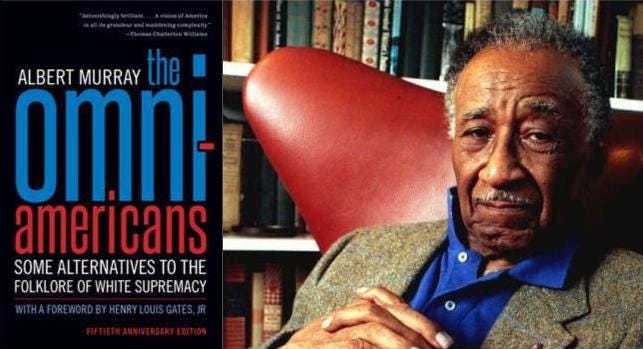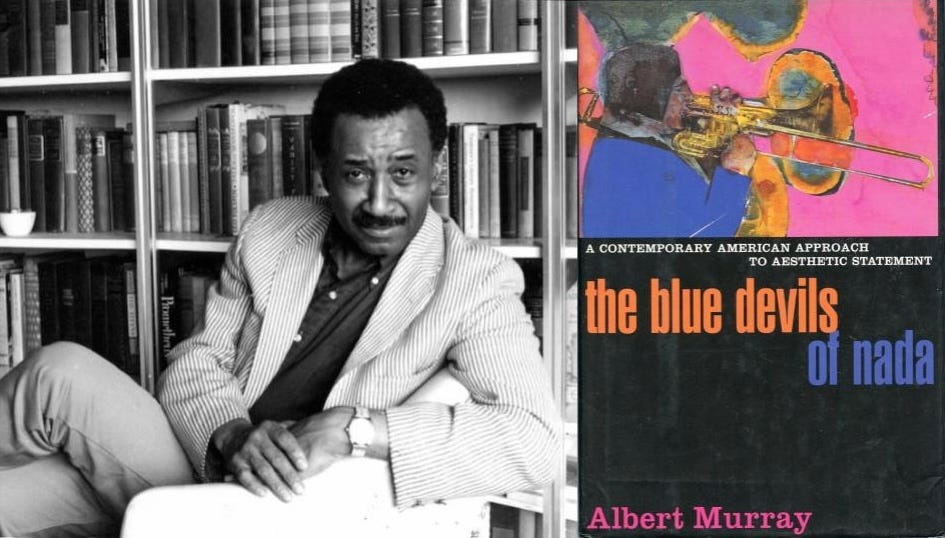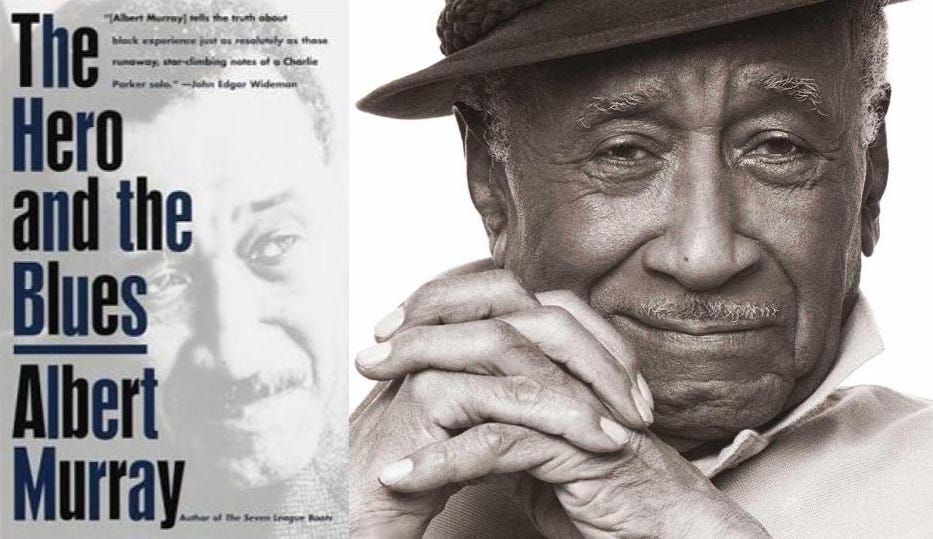Introduction to "The Omni-American Review"
A new journal pays homage to Albert Murray's vision of American excellence
Announcement
INTRODUCTION TO THE “OMNI-AMERICAN REVIEW”
A new journal pays homage to Albert Murray’s vision of American excellence
Aryeh Tepper
Editors’ note: We’re delighted to announce the launch of a new journal, The Omni-American Review (TOAR), inspired by the writings of blues and jazz theorist Albert Murray and featuring an all-star cast of authors. Created by our friends Aryeh Tepper and Greg Thomas of The Omni-American Future Project, TOAR explores American culture in its pluralistic integrity and thus also celebrates American identity in its multiethnic complexity. This “Omni-American” perspective stands as a unifying yet multivocal alternative to our current politics and culture of monotonous divisiveness. This post reprints a version of Aryeh Tepper’s “Introduction” to the first issue of TOAR.
Welcome to The Omni-American Review, a journal of arts and intellectual life dedicated to exploring and celebrating the depths of American culture. Our name is an homage to The Omni-Americans, Albert Murray’s 1970 book written from the heights of his Harlem apartment where Murray redefined the lines of American identity. The Omni-American Review likewise aspires to be a spiritual-intellectual home for those who know that “for all their traditional antagonisms and obvious differences, the so-called black people and the so-called white people of the United States resemble nobody else in the world as much as they resemble each other.”
That passage is classic Murray, and it is fitting that we dedicate our inaugural issue to Albert Murray’s life and work. As the essays, conversation, presentation and two eulogies included in this initial offering all say in different ways, Murray’s time has come. There is a hunger in the land for a robust cultural complement to the Civil Rights Movement; our contribution to satisfying this noble desire is a collection of articles transmitting a joyful, resilient and triumphal sense of life free from the resentment infecting America’s illiberal left and right. In Albert Murray’s America the center doesn’t just hold, it swings.
Several contributors to our first issue were Murray’s friends and students. Prof. Henry Louis Gates, Jr., host of PBS’ “Finding Your Roots” and celebrated scholar of English and African-American Studies, apprenticed with the master in Manhattan bookstores and in Murray’s Harlem apartment. Gates honored Murray in return by penning a 1996 New Yorker profile, “The King of Cats.” In his contribution to this collection, “A Tribute to Albert Murray,” Gates praises his teacher as “commanding on the page” but “equally impressive in the flesh,” a man who first stepped on the scene by rejecting the idea that “the black experience” is “an entity separate from…white American culture.” Instead, “Murray argued that ‘American’ and ‘Negro-American’ culture were mutually constitutive.” This “larger vision” of America’s “marvelous blend” set in relief the irony of “the clench-fist crowd… scrambling for cultural crumbs” while Murray “was declaring the entire harvest board of American civilization to be his birthright.”
Prof. Bob O’Meally is a pioneering scholar of American literature and Jazz Studies who also chauffeured the King of Cats around town. “Adoption and Hospitality: Celebrating the Murray Spirit” is an adaptation of an oral presentation that O’Meally opens with an anecdote from a 1973 Harvard conference—
when I was an undergraduate there…(Murray) told me that he had been adopted and that adoption became an important part of his philosophy. He said that adoption is from a Latin word, meaning ‘to choose.’ And the fact that his adoptive parents chose him was part of the enrichment for life.
In O’Meally’s concluding vignette, Murray and his wife, Mozelle, are the elders choosing to host O’Meally and his four-year-old son Gabe in their Harlem apartment, “Mrs. Murray had a beautiful sing-song voice… ‘I know my boy would like to have some cake.’” When it came time to go home, Murray invited Gabe, a first-time guest, to “‘come over here and give your granddaddy a big hug right now.’ And he hugged him tight.” That warm, welcoming sense of life, “‘Come on in. We're all in this thing together.’ That's the Murray spirit of things.”
Murray’s warm welcome extended to receptive graduate students like Prof. Joel Dinerstein, the author of three books on ‘cool’ whose “Albert Murray, the Blues Existentialist” revisits a scheduled thirty-minute conversation in Murray’s Harlem apartment that blossomed into “an epic four-hour mentor–disciple discussion about music, dance, and vernacular American culture.” During an Armagnac break from “the controlled whirlwind of Albert Murray’s intellectual universe” – swilled and knocked back in “small, engraved silver chalices, one for each of his books” – Dinerstein reimagines Murray as an “existential innovator” offering blues-idiom affirmation in place of angst. The connection to existentialism would have been clearer if Murray had “entitled The Blue Devils of Nada, his work on aesthetic theory, something like Blues and Nothingness.” Nevertheless, Murray remains “the hippest intellectual of the twentieth century” with “few peers in his understanding of the artist’s role in a democracy.”
New York literary doyen Leon Wieseltier affirms Murray’s importance, but on more primal grounds. Wieseltier’s eulogy for his longtime friend, “The Master of Melancholy,” is the first of two contributions explicitly linking Murray to Jewish thought. Opening with Rabbi Nachman of Bratslav’s rule that “it is forbidden to despair,” Wieseltier recalls that “many years after (studying) R’ Nachman’s teaching” he discovered another version of “spiritual action to prevent spiritual defeat” in Murray’s “theory of the blues, which was also his theory of existence.” The blues music stomps the blues feeling, and as Murray pointed out “with that sly and erudite twinkle in his eye…there is no weariness in ‘The Weary Blues.’” Wieseltier honors his friend by placing him on the shelf next to ancient sages: “This is wisdom literature. Its grand theme is: how to go on.”
Towards the end of his eulogy, Wieseltier drops a charged but hidden Jewish reference by noting how Murray resisted the “lachrymosity” that reduces Black American experience “to the sum total of its horrors.” The term “lachrymosity” signifies Prof. Salo Baron’s critique of what Baron called the post-emancipation “lachrymose conception” of Jewish history that the legendary historian first articulated in “Ghetto and Emancipation” in 1928. In the words of Warren Zev Harvey, Professor Emeritus in the Department of Jewish Thought at the Hebrew University of Jerusalem and a contributor to this collection, “Baron forcefully rejected as untrue the dominant view among scholars which saw Jewish history as nothing but a bleak succession of miseries, persecutions, and pogroms.” The parallel in place, Harvey extends, elaborates and refines the comparison in “Albert Murray vs. the Lachrymose Conception of Afro-American History,” his reading of Murray’s The Hero and the Blues. While Baron and Murray both criticize histories that emphasize victimization, Harvey posits a pedagogical question as their ultimate concern, “Do we seek to promote self-pity or self-reliance?” If we choose self-reliance, Murray provides equipment for the quest: “Albert Murray’s The Hero and the Blues…is a critique of lachrymosity and a guidebook for heroes.”
The fact that Wieseltier and Harvey independently note the correspondence between Murray and Baron demonstrates the naturalness and the depth of the comparison. It would be remiss not to linger over the new perspectives that emerge from this rooted-cosmopolitan, Omni-American meeting of minds. Wieseltier and Harvey discover in Murray’s thought a cross-cultural parallel for thinking about Baron's critique of the “lachrymose conception” of Jewish history. At the same time, they strengthen Murray's claim in The Omni-Americans that interpreting Black American life in terms of European Jewish victimization by projecting “ghettos” onto American inner-cities is a mistake: “Real ghettos...represented profound differences in religion, language, and food customs and were even geared to a different calendar.” We can imagine Wieseltier and Harvey robustly nodding their assent. As Baron wrote, “There were locks inside the Ghetto gates…before there were locks outside.” The lachrymose lens, it turns out, is an equal-opportunity distorter. Murray and Baron rectify the distortion, however, by removing the veil of lachrymosity that confuses Black American experience and Jewish history. Once removed, Wieseltier and Harvey focus on the inner strength stylized in Albert Murray’s writing that reflects and connects (Black) American and Jewish cultures in their depths.
Essayist Thomas Chatterton Williams traces the process of discovering Murray’s intellectual firepower in “The Most Extraordinary Nonfiction Book I'd Ever Read,” a conversation with The Omni-American Review co-editor Greg Thomas. “Astonished” as an undergrad by Ralph Ellison’s bold vision of “the mongrel nature of American society” portrayed in Invisible Man, Chatterton Williams was a graduate student when Murray protege Stanley Crouch advised him to check out Murray’s thought. Chatterton Williams followed the thread and subsequently discovered that “Invisible Man is coming out of ideas that Ellison had been talking about with Murray.” Humbled by Murray’s dignified commitment to doing the work “without worrying about whose shadow might be cast over him,” Chatterton Williams ultimately concluded that Murray is “the more important figure” whose writing remains the standard for thinking about America’s “cultural synthesis at its best.”
While Murray’s thought is celebrated by scholars, artists and writers, he published a quartet of novels from 1974 - 2005 that were not always well-received. Some of Murray’s students complained that things come too easy for Scooter, Murray’s alter ego hero. Novels without tension, it was said, are best read as prose-poetry. In “Albert Murray, Scooter, and the Burden of Expectation,” writer Clifford Thompson dissents from the critical opinion by “pointing to a dynamic tension” in Murray’s novels “that is missed by many of his readers” but is found in Murray’s psychological finesse: “The dragons don’t breathe fire or even wear white hoods, they nest themselves in one’s consciousness and weigh you down with the burden of great expectations.” Once the burden is in place, however, more felt than stated, like the sound of Scooter’s walking bass, the pressure drives Murray’s narrative forward.
Dan Asia is an award-winning composer in the Western classical tradition, and in “A Classical Composer Reads Stomping the Blues” he turns to Murray for thinking about the foundational stories told by jazz and classical artists. Adopting Murray’s distinction between folk, pop and fine arts, Asia distinguishes, at the level of fine art, between the concerns of the classical composer and the jazz improviser: “If the classical composer is concerned with the finished product, the jazz improviser is more interested in the process of creation.” Being fine arts, these concerns are in the service of producing “something that matters.” Murray shows that the jazz musician’s process of creation is “a way of confronting, battling with, struggling with, those eternal feelings found in human beings.” Yes, “jazz is coming out of the Black experience in America,” but “it is not isolated or hermetic, but has universal implications.” Reflecting on Murray’s heroic interpretation of jazz, Asia’s thought settles on an abstract, meditative note, “Classical composition is about perfection, while jazz improvisation is about life itself.”
Aryeh Tepper, co-editor of The Omni-American Review, makes the case that Murray’s heroic interpretation of jazz possesses depths best heard in dialogue with the tradition of classical political philosophy. In “Albert Murray’s Conversation Partners, Ancient and Modern” Tepper shows how Murray’s conscious aspiration to use jazz “to shape the contours of American culture” connects him to “an old tradition” transmitted by the likes of Plato and Nietzsche “that takes seriously the power of music to shape the character of individuals and political communities.” Tepper then imagines Murray, Plato and Nietszche “trading fours” back-and-forth over the role of rhythm, lyrics and spiritedness, with Murray offering the provocative thought over a single-malt scotch that “when the modes of music change, the ways of the state change with them.” Via music, Murray shows us human excellence at home in American liberal democracy.
In the penultimate contribution to this collection, “Monumental Vision, from the Black Roots of Ancient Egypt to Blues Idiom Wisdom,” Greg Thomas honors Albert Murray as “a great teacher” who aided Thomas’ quest “to resolve a tension within myself over how to evaluate history, culture, and politics in relation to my people’s struggle.” Murray’s Harlem apartment was the seminar room, and the professor’s pedagogical tools included merciless ribbing of undercooked ideas like “the black roots of ancient Egypt.” Reminding Thomas that “when Nelson Mandela comes to the United States, he wears a Western suit,” Murray “replaced a misguided focus on African origins” with a vision of home-grown culture that plants its flag among the peaks of human achievement, “Through Murray, I know that the triumph and meaning of jazz and the blues in the twentieth century are as monumental as the building of the pyramids in ancient times.”
Karen Lehrmen Bloch’s “A Jazz Concert Relives a Dream” concludes The Omni-American Review’s first issue by taking us to Minton’s Jazz Club in Nov., 2022, when the Omni-American Future Project, with Thomas and Tepper hosting, set the stage and the Itamar Borochov Quartet provided the vibe for an evening that elegantly but authoritatively placed the focus on “culture, not race.” With the band killin’ and bite-sized portions of Murray, Ellison and friends read by honored guests, Lehrmen Bloch left the event with a series of insights: “The Omni-American tradition serves as a bridge between ethnicities, provides ‘equipment for living,’ and—at its best—propels a drive for honor, nobility and excellence: a heroic approach to life.”
The Omni-American Review hopes you enjoy our inaugural issue. We look forward to exploring and celebrating the depths of American culture with you in future issues, as well.
Coda
The contributors to The Omni-American Review’s first issue are almost equally divided between Black Americans and Jews. This was not planned (not all requests for essays succeed), but it is surely worth noting. Thanks to the excellent contributions, robust cultural exchange and noble purpose offered in these digital pages, The Omni-American Review presents itself as evidence: the Black American-Jewish alliance continues.
Read the first issue of The Omni-American Review here.
Aryeh Tepper is the Co-Director of the Omni-American Future Project and the Co-Editor of The Omni-American Review. He also serves as the Director of Publications for the American Sephardi Federation, where he edits Sephardi Ideas Monthly and Sephardi World Weekly. Aryeh is the author of Progressive Minds, Conservative Politics: Leo Strauss' Later Writings on Maimonides (SUNY Press, 2013). His writings on the intersection of political philosophy and music include “Leo Strauss, Bigotry and the Blues” (Moment Magazine, 2021), “Albert Murray, Philosopher of Jazz,” (The Weekly Standard, 2016), and “The Problematic Power of Musical Instruments in the Bible” (Interpretation, Vol. 41:2-3, 2014-15). Aryeh has lectured on music at The Columbia University Center for Jazz Studies, The National Jazz Museum in Harlem, The University of Arizona, Princeton University, Ben Gurion University and the Mizpeh Ramon Jazz Conservatory.








America is like no other nation, no other idea. It is a tapestry of threads and patterns, a symphony of strains and etudes, a chef's kitchen suffused with particulars and essences. There is a frightening movement to flatten it out, to reduce it to tribality. Thankfully, there are of those of us who see the glory of the Great American Experiment, still vital 248 years in.
As Mark C Still has eloquently summarized, this is wonderful and needs to be in the air we breathe. To this end I recommend "The Anglosphere Challenge" by James C. Bennett